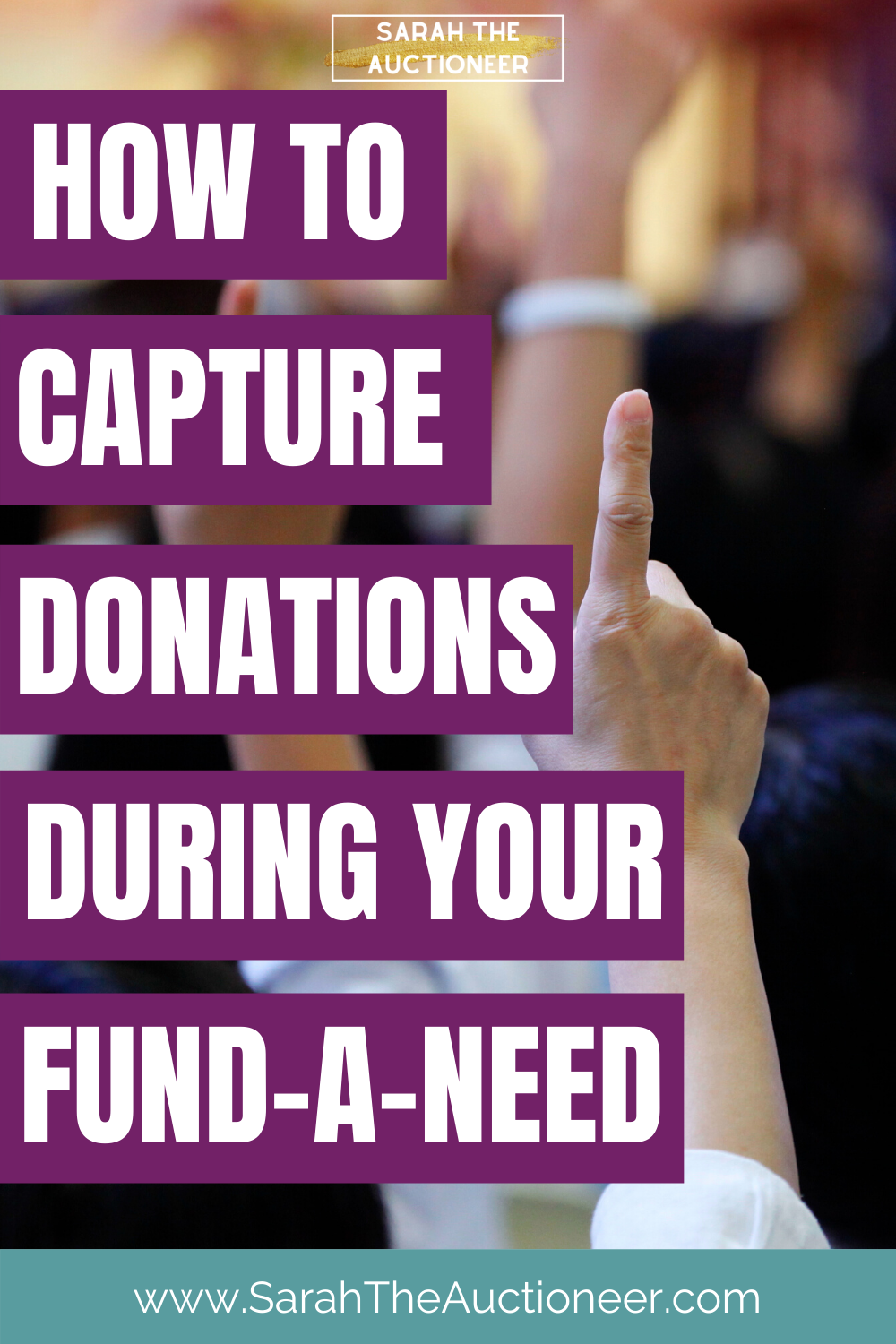The Fund-A-Need (or fundraising appeal) is the biggest moment of your gala. Every part of your event should be pointing and building momentum to this moment. This is when you ask the guests to join you in your mission through a financial contribution. If you’ve done all the right things, your event will be successful.
However in order to make sure your donors follow through on their commitment, you need to have a thought out system in place to ensure that you properly capture the donations.
How do you capture donations during your fundraising appeal or fund-a-need?
Traditional Paddle Raise
The traditional paddle raise is the most common and traditional way to conduct your fundraising appeal, and it's how most auctioneers like to do it because it's easy to control and explain to the audience. This is where the auctioneer or whoever is conducting the Fund-A-Need calls out donation levels and people raise their paddle at those levels.
There are 2 ways to capture donations during a traditional paddle raise.
Read each bid number out loud.
Pen & Paper Method
This sometimes takes a long time, so if you have more than 500 people in your crowd, it probably isn't the best way to capture these donations. With that being said, there is something amazing about the momentum it creates as I walk around the room calling out those numbers and thanking each bidder individually.
When I conduct a Fund-A-Need this way, I always thank each bidder. I do this for two reasons. First, every donor deserves to be thanked because their contribution is so important. Second, saying "thank you" between each bid number gives the recorders a moment to write down their number. Many auctioneers rush through the numbers because this part can take a while, but if they go too fast, numbers are missed and donations are not captured.
You will need several (3-5) volunteers writing down the bid numbers at each donation levels so you can cross reference their records and make sure no one gets missed.
Utilizing Mobile Bidding Technology with this method
This takes a very talented, detailed and quick-typing volunteer to achieve. As the auctioneer reads the bid numbers out loud, the volunteer types them into the system live. This provides the momentum of reading the numbers out loud, while also being able to track the amount live on the screen.
Refer the donors to a donation card on the table
With this, the auctioneer would do a traditional paddle raise and thank the donors as their hands fly in the air. After the auctioneer gets through all of the levels they would say "Thank you for everyone who committed to make a difference tonight. To follow through on your commitment, please fill out the donation cards on the center of your table."
This can be a nice method because the auctioneer can calculate the amount that is being raised in their head as they go. This helps with the auctioneer know how much has been raised so that they can adjust how they need to enhance their ask as they go. An experienced fundraising auctioneer knows how to work a room as needed for this.
Utilizing Mobile Bidding Technology with this method
If you want all our donations captured through mobile bidding, but also want to maintain your traditional paddle raise, you can have your auctioneer announce at the end of the Fund-A-Need that they can follow through on their commitment on their phones. NOTE: they need to announce it at the very end of the Fund-A-Need because the moment you have some people raising their hand while others are just entering numbers on their phone, you've lost momentum which means you've lost money.
Want to get fancy and use Mobile Bidding?
Oh man, I LOVE mobile bidding. This is where we are moving and you need to make sure your auctioneer is on board with this. I know many of my fellow auctioneers who don't love to use it and prefer to use the traditional paddle raise, which is fine because like I mentioned before, there are ways to integrate mobile bidding into a traditional paddle raise.
Tips for a utilizing mobile bidding technology successfully
Focus on 100% participation over donation levels
Because you likely won't have people raising their paddles at different levels, encourage your donors to give at any level as long as they give. I usually say something like "it doesn't matter whether you give $1 or $25,000 today, what matters is that you make the decision to be a part of the solution by pulling out your phone and taking action right now."
You are still going to get your $25,000 or $10,000 donors who planned for that, and if you had a compelling introduction to your Fund-A-Need they may even give more than they budgeted, but with this method you are going to capture donations from all of those low level donors who weren't planning to give. There are actually studies about the psychology behind this that I can get into another day, but basically giving them a low risk option of $1 compels them to take action, but then they don't want to be perceived as cheap, so they rarely actually give just $1.
Again, your auctioneer has to be on board with this. I have spent a lot of time studying the phychology behind this and applying and honing these methods, so I am very comfortable and love doing it this way.
Make sure everyone knows how to access mobile bidding when they check in
Make sure everyone is signed on to mobile bidding at check in. Most systems text bidders a link. For best results, have them sign in right there with your check-in volunteers otherwise many people will put it off and never actually sign in. If they are signed in before the Fund-A-Need begins, they will be ready to pull it out and give. It can take a while for people to get signed on, which means it takes a while for those numbers to go on the screen, which means that the momentum slows down. That can be really rough for your final numbers.
Give step by step instructions on how to give
Have your auctioneer walk your guests through the donation process on their phones. It helps to have screen shots on a page in your program and on the screen as a visual guide. Now only do your guests need to be clear on why they are giving money, but they also need to be clear on how to give their money. As soon as something becomes unclear, you lose money.
Make sure your server and wi-fi have the capacity for your group
In a world of unlimited data, people will still want to use wi-fi to use their mobile bidding. I will tell you that most venues are not designed to have 1000+ (or even 200+) people on their wifi system all at the same time. You will want to plan to bring in reinforcements for this. It will be an additional expense, but it is better than all of the money it will cost you when your wifi goes out and no one can give and you lose their donations. Some mobile bidding companies, like Auction Harmony, actually bring their own modems and wifi and understand the technology necessary to make your event successful. Even if your mobile bidding company doesn't provide this for you, I encourage you to get their recommendations and follow their instructions on this. They are professionals and know exactly what you'll need for your event.
Do a test run before your event
I did an event with mobile bidding last fall and the guests were all putting their donations into their phones, but nothing was showing up on the screen. It was the most painful fund-a-need ever. It took about 5 minutes to get the numbers on the screen at which point we lost a ton of momentum. We ended up hitting their goal and breaking personal records for this group anyway, but it definitely lost a lot of power and momentum because of a technical difficulty. Test this before your guests arrive. Make sure the donations are being properly represented on the screen so that when the real Fund-A-Need comes around, you don't have to worry.
Determine if your demographic is right for mobile bidding
While it seems that everyone has a smart phone these days, that is not true. If you have a group that is millennials through baby boomers, you are probably safe with mobile bidding. However, if your group is mostly early baby boomers and older, you may want to stick with a traditional paddle raise for their group. Younger generations feel at home with their smart phones and actually feel weird raising their hands during a traditional paddle raise. Talk to your auctioneer about the demographic of your guests because they will help you determine what is best for your group.
Do not mix a traditional paddle raise with mobile bidding.
You must choose which method you are using because once you have both methods going, I guarantee you will lose momentum and therefore lose money. When mobile bidding first came out this is how most auctioneers handled it, including myself. It was awful! Some people raised their hands and wrote checks, while some savvy bidders put their donations in their phones. Then they would put the thermometer on the screen and it would be so disappointing because it only showed half of the actual donations. This low number did not motivate guests to give and meet the goal. Instead it discouraged people to bid, because they perceived the goal could not be met. Trust me on this. Using both methods together does not work. Determine which method is right for your demographic and stick with it. Strategize specifically for the guests at your event and you will be successful.










